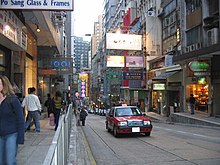Wellington Street, Hong Kong
 The eastern part of Wellington Street | |
| Native name | 威靈頓街 Error {{native name checker}}: parameter value is malformed (help) |
|---|---|
| Location | Central, Hong Kong |
| Coordinates | 22°16′54″N 114°09′20″E / 22.28180°N 114.15550°E |
| East end | Wyndham Street |
| West end | Queen's Road Central |
| Construction | |
| Completion | c. mid-1840s |


Wellington Street (traditional Chinese: 威靈頓街; simplified Chinese: 威灵顿街; pinyin: Wēilíngdùn Jiē; Cantonese Yale: wai1 ling4 deun6 gaai1) is a one-way street located in Central and Sheung Wan, Hong Kong. Named after Arthur Wellesley, 1st Duke of Wellington, it stretches from Wyndham Street to Queen's Road Central. The two sides of street is a mosaic of old and new buildings. Varieties of trades can be found on the street level. Street markets can be found in the adjacent lanes.
Location
The street is located at the bottom of Victoria Peak on Hong Kong Island and next to Queen's Road Central which serves as one of the main roads through the central business district. Wellington Street ends westwards at the end of Central and the beginning of Sheung Wan.
History
The old Roman Catholic cathedral—the first Catholic church in Hong Kong—was built in 1843 at the junction of Pottinger Street and Wellington Street[1] and was destroyed in a fire in 1859. It was rebuilt with iconic twin steeples at its facade. However, space constraints led to a different site being selected in the 1880s;[2] this was located above Caine Road by the Glenealy Ravine. When construction on the Cathedral of the Immaculate Conception was completed 1888, the old Wellington Street cathedral was demolished.[3]
Japanese prostitutes constituted the majority of Japanese residents of Hong Kong in the late 19th century, and there were 13 licensed Japanese brothels and 132 prostitutes in Hong Kong in 1901. These brothels were initially located in Central, mostly on Hollywood Road, Stanley Street and Wellington Street. They later moved to Wan Chai.[4]
Features
The street houses many shops on ground level and offices above with some housing. Notable businesses in Wellington Street include restaurants such as Mak's Noodle, Yung Kee,[5][6] Lin Heung Tea House (莲香楼; lit. "Fragrant Lotus")[7][8][9] and Tsui Wah Restaurant.[10]
See also
References
Footnotes
- ^ Wordie, Jason (2002). Streets: exploring Hong Kong Island. Hong Kong University Press. p. 62. ISBN 978-962-209-563-2.
{{cite book}}: Cite has empty unknown parameter:|coauthors=(help) - ^ Wiltshire, p. 189
- ^ Chan, Dora (September 12, 1999). "Wellington Street". South China Morning Post. p. 32. Retrieved April 15, 2013. (subscription required)
- ^ Ng, Benjamin Wai-ming (October 7, 2005). "Chapter 6 - Making of a Japanese Community in Prewar Period (1841-1941)". In Chu, Cindy Yik-yi (ed.). Foreign Communities in Hong Kong, 1840s-1950s. Palgrave Macmillan. p. 120. ISBN 9781403980557.
- ^ Jessica Lam, Food, South China Morning Post, 7 June 2007
- ^ "Yung Kee", Frommer's, 2010, retrieved 2010-07-15
- ^ Liam Fitzpatrick, "Hong Kong: 10 Things to Do. Lin Heung Tea House", Time Travel
- ^ Hong Kong Tourism Board: Lin Heung Tea House
- ^ "Lin Heung Tea House: Dim sum elder", CNN Go, 14 July, 2009
- ^ "Branch information – Hong Kong Island". Tsui Wah Restaurant. Tsui Wah Group. Retrieved April 15, 2013.
Bibliography
- Wiltshire, Trea (2012). A Stroll Through Colonial Hong Kong. FormAsia Books Ltd. ISBN 978-988-15562-3-3.
